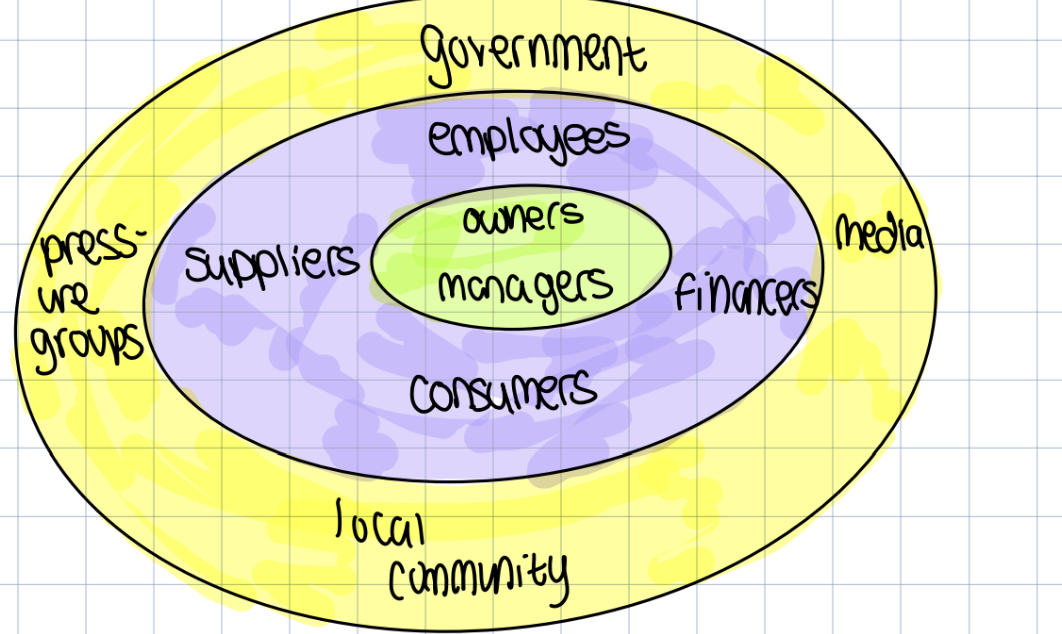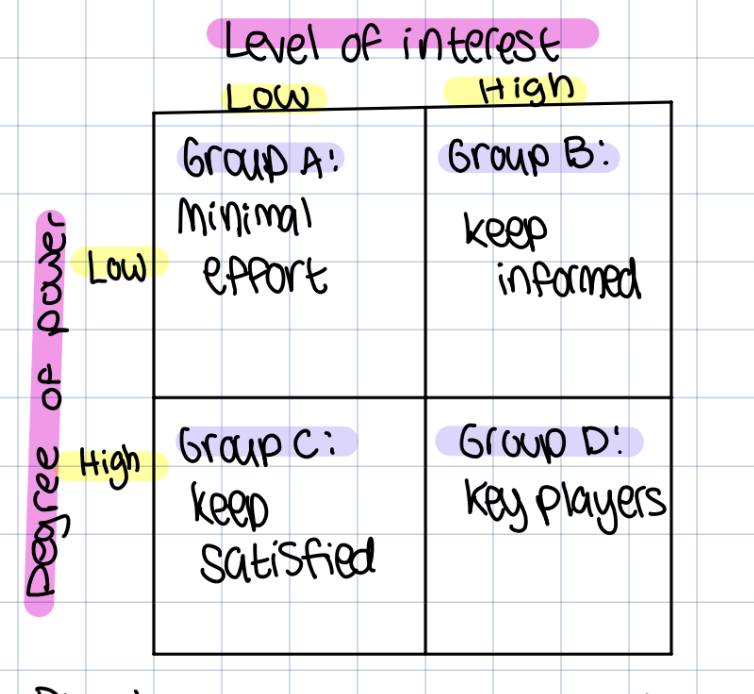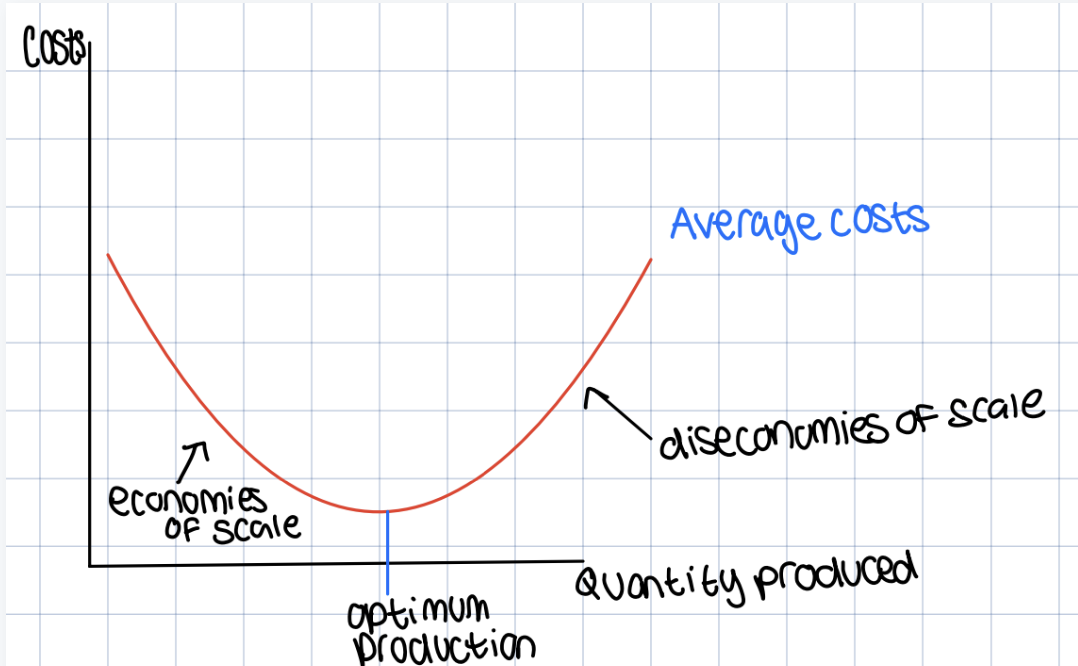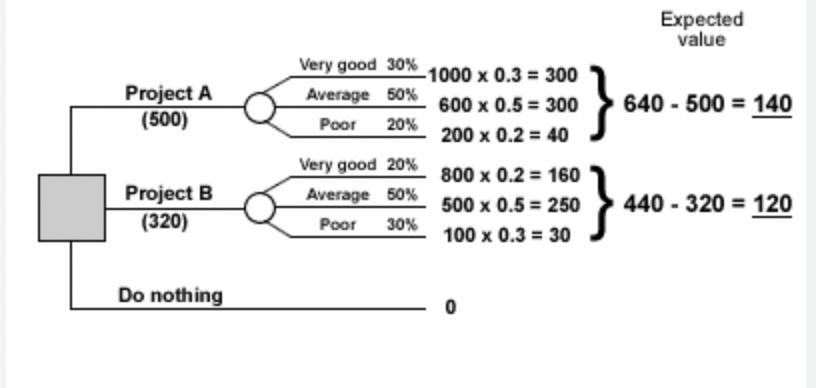Business economies of scale
1/83
There's no tags or description
Looks like no tags are added yet.
Name | Mastery | Learn | Test | Matching | Spaced |
|---|
No study sessions yet.
84 Terms
Stakeholders
Vested interest in the business as its actions will directly effect them
Internal stakeholders
Individuals or groups that are inside the business
Multiple stakeholder interests
Employees who own shares, employees who are still citizens and therefore can vote too
The interests of internal stakeholders
Shareholders- return on their investments
CEO- coordinating business strategy; profits
employees and unions- protecting their rights and working conditions
middle managers- tactical objectives of their functional area
Interests of external stakeholders
government- how business operates in the business environment
suppliers- maintaining a stable relationship
consumers- best product that meets their needs
media- impact of business in news stories
local community- impact of business on local area
competitors- effect their business operations
conflict between stakeholders interest
although all stakeholders have a stake in the business, their focuses are different
any decision of importance such as general pay rise at the business will cause different reactions from different stakeholders
friction may result and alliances may form
Succesful businesses
satisfy the stakeholders interests as suffiencietly as possible
this is not so complicated for sole traders but for large businesses it is
Stakeholder analysis
Large businesses that have complicated stakeholder interests prioritise or rank the interests of various stakeholders
do it in two ways
Circle method stakeholder analysis
How close the stakeholder is to decision making in the business
try to satisfy the stakeholders closest to the center (decision makers)

Power interest model
By placing each stakeholder in the matrix, business can decide on strategy
A- rarely a problem, safely be ignored, limited attention to their interest (media)
B- make this group feel included, newsletters, events etc (consumers)
C- power to influence over others, flatter self esteem of those in this group, make them feel important (employees)
D- important, consult with them before decision making, focus on their needs (owners)

Scale of operations
Size or volume of output, increased scale of operations means producing more in greater volume
Economies of scale
Reduction in average unit cost as business increases in size
if a business increases scale of operations and becomes more efficient in doing so
Diseconomies of scale
increase in average costs as business increases in size
if a business experiences inefficiencies when it grows, it has achieved diseconomies of scale
fixed vs variable costs
fixed costs are costs that do not change as production changes (rent)
variable costs are costs that vary as production changes (raw materials)
total costs
variable costs plus fixed costs
Average costs
total costs/ quantity produced
Optimum production graph
Increasing quantity produced in beginning, and costs decrease, after a certain Time of increasing quantity produced you get optimum production when average costs are at the lowest so profit is at its maximum, after this you continue increasing the quantity produced and start to experience inefficiencies causing average costs to increase like if you hire too many people in the kitchen and even with the extra costs of paying them to make more pizzas, they are just getting in the way of each other and end up making less pizzas for more costs of paying more people

Internal economies of scale
efficiencies a business itself can make
Technical economies of scale internal
bigger units of production lowers costs as the increase in variable costs is spread against a spread of fixed costs ex. a container ship with one crew, one fuel bill, one big fee cheaper than 2 small ones
managerial internal economies of scale
bigger businesses can afford to have mangers specialising in one job as opposed to one manager doing everything, more efficient
financial internal economies of scale
bigger businesses are less risky than smaller ones
marketing internal economies of scale
bigger businesses can run more effective marketing campaigns
purchasing internal economies of scale
big businesses can get discounts by bulk buying
risk bearing internal economies of scale
big businesses can afford to produce a big range of products, spread the risk of one product family
external economies of scale
efficiencies the business achieves because someone else has expanded
consumers external economies of scale
shopping mall increases number of potential customers, more people go to a mall than independent shop, Whole range of businesses benefit from infrastructure
employees external economies of scale
some geographic areas focus on one industry, operating in these areas allows for a business to benefit from lower recruiting and training costs like Hollywood with many actors
Internal diseconomies of scale technical
airports too big to land at smaller airports
internal diseconomies of scale
inefficiencies that the business itself makes
managerial internal diseconomies of scale
over specialised managers who cannot or will not work outside of their area of expertise for anyones benefit
financial internal diseconomies of scale
big businesses with a lot of surplus cash make poor investments
marketing internal diseconomies of scale
big businesses can make big marketing mistakes
purchasing internal diseconomies of scale
large businesses often buy too much stock so can end up being costly if capital expenses is greater than cost savings from buying in bulk
risk bearing internal diseconomies of scale
sharing of responsibility if something goes wrong; some risk exists in all economic activity
external diseconomies of scale
inefficiencies that an external source makes for a business
external diseconomies of scale employees
if one geographical area becomes too concentrated on one economic activity, shortage of skilled workers in the industry will occur, businesses will have to pay high wages to attract these workers
reasons for a business to grow
survival, economies of scale, higher status, market leader status, increased market share
survival reason for business to grow
large firms have a greater chance of surviving, less likely to fail or be taken over
economies of scale reason for business to grow
large firms enjoy economies of scale, greater profits, higher returns
higher status
large firms have more status and more motivation for employees
market leader status
if your the market leader, you can shape market habits and give yourself a competitive advantage
increased market share
large companies with large market share can control the market by determining prices and decide which services will be the industry standard
reasons for a business to stay small
greater focus, greater prestige, greater motivation, competitive edge, less competition
greater focus
small businesses can focus investments where they want and where they can earn profit, often having greater return
greater prestige
more exclusiveness, can charge more for goods and services, more profit
greater motivation
more prestige, motivate employees, employees feel like they matter to the business
competitive edge
being small, more personalised service, more flexible
less competition
such a small and niche market, sometimes big businesses do not want to even get involved
internal growth
organic, happens slowly and steadily, grows from existing operations of the business, long time, no risk
selling more products or developing a bigger range
external growth
quicker, riskier method of growth, expands by entering arrangement to work with another business, high risk high reward
external growth methods
merger- two businesses join together
acquisition- one business taking over the other
takeover- acquisition is unwanted by the company being acquired, only cubically held companies can be taken over
all result in one bigger business
horizontal integration
2 businesses same line of business, same chain of production, results in increased market share and power
vertical integration
one business integrated with another at different stages in production chain, can be to ensure supply, avoid taxing and price controls
backwards vertical integration
business involved in earlier stage of chain of production, business wants to protect its supply chain
forwards vertical integration
business involved in further forward in chain of production, secure an outlet for its products
conglomeration
two businesses in unrelated lines of business integrate, known as diversification, to decrease corporate risk
Mergers and acquisition disadvantages
can be costly, high legal and consulting fees
culture clash with employees from companies
joint ventures
2 businesses agree to combine resources for a specific goal over a period of time, separate business created with funding by 2 parent businesses, after time period is over new business is dissolved or incorporated into one of the parent business
advantages and disadvantages joint ventures
advantages- transfer of skill, knowledge, experience, greater sales without losing legal identity as a company
disadvantages- possible disagreements between partners
strategic alliances
more than 2 businesses can be apart of an alliance, no new business is created simply agreement to work together for mutual benefit, still remain independent businesses, member ship is fluid
advantages and disadvantages to strategic alliances
advantages- more members
disadvantages- more challenging to coordinate on a agreement, no legal entity, alliance will have less force, fluidity of members, alliance lack stability
franchises
original business- franchisor- developed the business concept and product/service sells the right to offer the concept
business- franchisee- buys the right to offer the concept and sell the product/service, must be consistent with the original business concept developed by the franchisor
rapid form of growth- franchisees know local conditions and market and language to grow
costs- franchisee must pay for franchise itself, must pay royalties (percentage of sales to franchisor)
franchisor provides
stock
uniform
training
legal and financial help
global advertising
global promotion
franchisee provides
employ staff
set prices and wages
pay royalty
local promotions
only sell franchisor products
advertise locally
advantages and disadvantages to the franchisee
advantages-
product exists and is well known
selling product format is established
set up costs are reduced
secure stock supply
franchisor helps with legalities, managers, finances, technicals
disadvantages-
unlimited liability for franchise
pay royalties
no control over what to sell
advantages and disadvantages franchisor
advantages-
quick access to wider markets
use of local knowledge and expertise
no risks or liability for franchise
more profits
makes all global decisions
disadvantages-
loses control in day to day business running
image can suffer if it fails
the impact of multinational companies on host countries advantages
economic growth- provides employment develop local suppliers, paying taxes
new ideas- introduce new ways of doing business and interacting socially
skills transfer- develop skills of local employees, can set up their own business with what they learn
greater choose- domestic market will benefit with more variety in products
disadvantages of multinational companies on host country
profits being repatriated- bulk of MNCs profits are rerouted away from host country
loss of cultural identity- appeal of domestic products, ways of doing business, cultural norms may all suffer
brain drain- many high skilled employees may look to work for the MNC in another country
loss of market share- as MNCs take over domestic market, domestic producers may suffer
depreciation
decrease in value of a non current asset over time due to wear and tear or becoming obsolete
2 methods of calculating this,
straight line method
Annual depriciation= original cost- residual value/ expected useful life of the asset
residual value- estimation of its worth or value over its useful life
remember this only gives you annual, remember to multiply it for more years if needed
advantages-
simple to calculate, predictable expense spread over a number of years
suitable for less expensive items, can be written off within the assets useful life
disadvantage-
note useful for plant machinery and more expensive assets as it does not cater for efficient loss or increase in repair prices
can inflate the value of assets which may lose greatest amount of value in first or second usage
units os production method
depreciation of asset based on usage
depreciation expense= (cost basis of asset- salvage value) / estimated total units to be produced over useful life x actual units produced
cost basis= original value of asset
salvage value= value of asset if it were to be sold at the end of its useful life
advantages-
asset based on usage not only time, declining physical value of asset taken into account
disadvantage-
only useful to manufacturers and producers
can be complicated to calculate
ratio analysis
financial analysis tool used in interpretation and assessment of a firm’s financial statements
gross profit margin gross profit/sales revenue x 100
how much profit they retain from what they sell in percentage
strategies to improve-
increase price for products in markets where there is less competition or consumers less sensitive to price change
source cheaper suppliers of materials
promotional strategies
profit margin profit before interest and tax/sales revenue x 100
profit that remains as a percentage after deducting all costs from revenue
strategies to improve
check indirect costs to see where unnecessary expenses can be avoided
negotiate with key stakeholders to cut costs
return on capital employed = profit before interest and tax/ capital employed x 100
capital employed= non current liabilities + equity (total assets minus total liabilities) ( equity is also share capital plus retained earnings)
asseses the returns a firm is making from its capital employed
how to improve-
reduce the number of long term loans while insuring that profit before interest and taxes stays the same
pay additional dividends to shareholders
reduce retained profits and reduce capital employed
any values given that are not long term loans or profit before interest and tax are meant to be apart of equity
current ratio = current assets/ current liabilities
ratio expressed as 500,000/250,000= 2 to 1
current assets should be higher than current liabilities, then you have enough to pay off short term debt
current assets is lower than current liabilities you have financial difficulties to pay back short term debt
a high current ratio should also be avoided as that can mean too much cash being held and not invested, many debtors meaning there may be bad debts, too much stock held
how to improve
reduce bank overdrafts and choose more long term loans
sell existing non current assets for cash
acid test ratio- current assets-stock/ current liabilities
better indicator of how well a firm is able to meet short term debt as it removes stock from current assets because there is not guarantee stock can be sold and it can become obsolete
too high of an acid ratio has some implications like having too many debtors and too much cash being held
less than 1 to 1 is bad as it means a firm is in bad financial health and financial institutions should proceed with caution
strategies to improve
sell stock at a discount for cash
get more cash and debtors and less stock
less short term loans and more long term loans
stock turnover ratio= cost of sales/average stock (number of times)
average stock- opening stock + closing stock/ 2
measures how many times over a given period is the stock sold and replenished
if it is higher than means firm sells stock quickly and earns more profits from its sales, goods do not become obsolete quickly and business has good control over its purchasing decisions
strategies to improve
obsolete products must be exposed of to lower stock
narrower and better selling range of products
stock turnover ratio= average stock/ cost of goods sold x 365 (number of days)
how many days it takes to sell given stock
if it is higher than means firm sells stock quickly and earns more profits from its sales, goods do not become obsolete quickly and business has good control over its purchasing decisions
strategies to improve
try to find cheaper alternatives to lower the cost of your goods/ buy in bulk if possible
narrower and better selling range of products
debtor days = debtors/total sales revenue x 365
lower number of days is better as it provides the firm with working capital
too long of credit period could provide cash flow problems
strategies to improve
provide discounts or incentives to get them to pay back their debts earlier
firm could impose stiff penalties such as fines for late payers or forbidding them from buying again
creditor days= creditors/cost of sales
asseses how quickly a firm is able to pay its suppliers
higher ratio enables the firm to use available cash to fufill short term obligations, and not have to spend It all immediately on suppliers, but extending period too long may ruin relationship with suppliers
investors may see this ratio as a business being in financial trouble and will not want to invest
strategies to improve
having a good relationship with creditors such as suppliers gives you extended credit period
effective credit control, managers asses the risks of paying creditors too early vs how long they can delay making their payments
gearing ratio = loan capital/capital employed x 100
measures the extent to capital employed by a firm being financed by loan capital
capital employed includes loan capital, shares capital, and retained profits
measured as a percentage, high geared is above 50 percent and low geared is below 50 percent
high geared viewed as risky by finances, a lot of loan capital
low geared viewed as safe, not a lot of loan capital, but may not be borrowing enough to boost future growth, not risk taking, shareholders may see them as not offering good returns
strategies to improve
business finds other sources of funding that are not loan related
decide not to issue dividends to share holders to increase retained profits
debt factoring
when you know you are not going to get your debt back so someone buys your debt off of you for part of the debt you were supposed to get from the debtors and they chase down the debtor to get the debt and they will get profit from It
decision trees
helps managers analyse the probability of success of different strategies or options
circle for chance node
square for choice or decision
multiply the probability by expected outcome and add them all together and minus it from the cost it would cost to decide the best choice (branch) which has the highest expected value
